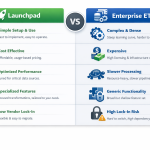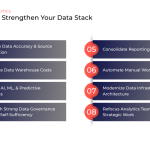
Data warehouses serve as a backbone for any analytics-focused business and are critical tools for storing and analyzing large volumes of data. An increasing number of companies are either considering or already have data warehouses in place to treat data as a digital asset.
This allows businesses of all shapes and sizes to own their data, analyze it to make better decisions, and provide speedy responses to competitive opportunities. However, as businesses navigate managing a data warehouse, they encounter several common data-related pitfalls. Here are three pitfalls to be on the lookout for:
1. Incomplete Data
The better the plan, the better the outcome. Before a single data point is stored in your data warehouse, it’s important to form a well-thought-out plan. A solid game plan will help keep your valuable records organized and complete. Here are a few points to consider:
- Identify where your data is currently stored (sources) and how to gain access to it.
- Choose a method to transfer data to the data warehouse (the use of an ETL application like Launchpad will prove to be critical for many sources).
- For historical data, determine the desired date range you want to archive for each data source.
- Think about how often the data will be refreshed/updated and what that process looks like.
- Target the relevant performance measures and gather feedback from stakeholders that will be reviewing your reports.
- If possible, consider what future insights may take center stage.
- Example: Perhaps your business is scaling, and there is an expanded need to report on business unit performance across additional measures.
- Storing data and querying that data has a real cost to it. Having a plan in place will help keep costs to a minimum.
2. Unorganized Data Warehouse
To maximize the use and value of a data warehouse, organization is critical. If users do not understand where the data exists and how to access it, then they will miss opportunities to uncover valuable insights. Most businesses have multiple analysts overseeing their data warehouse, so ensuring a structured and organized approach is key. Here is a quick example of how datasets and tables could be sensibly organized:



3. Inadequate ETL Process
Earlier, we mentioned that an ETL (Extract, Transform, Load) platform is essential. We are all aware that manual processes can fail and are generally not scalable. An ETL application, like Launchpad, can easily move massive amounts of high-quality data to your data warehouse tables and dynamically refresh that data as needed. Here are some of the benefits that an ETL app provides:
- Jobs can be configured to run automatically, and data from multiple sources can be transferred easily, with no manual data entry.
- Future data transfers can be scheduled, allowing for further automation and scalability.
- An ETL structures your data, which ensures quality and consistency.
- For many sources, like GA4, an ETL transfers flat tables to the data warehouse.
- This provides a huge organizational benefit when you begin to use table data in your queries/views.
- If the tables are not flat, they may have nested records that require the use of more complex queries.
An ETL improves both organization and quality. Here is an example ETL schema configuration. Note the preconfigured data types that make sense for the dimension or metric, which can all be pulled from a historical and ongoing perspective:

Most businesses will encounter additional pitfalls, but with a well-defined data strategy, involvement from stakeholders, a lens on overall data organization, and a proper ETL process, you will be well ahead of the game. That means you'll be able to sidestep some of those early issues that can manifest into larger problems down the road.
Need Help?
If you're having any trouble making the most of your data, then the experts at Calibrate would be happy to help show you what's possible. From walk-throughs and interactive demos to custom solutions, we'll help you set up a healthy analytics stack that fuels smart business decisions.





